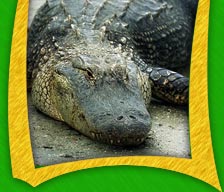| In
Florida, it’s not uncommon to see
local news stories about a gator making itself at home in a backyard,
swimming pool or pond. Whether we like it or not, alligators
and humans are close neighbors; and, with more human development
pushing into alligator habitats, we are going to get much closer.
|
 Photo Source: US Fish and Wildlife
Service
Photo Source: US Fish and Wildlife
Service |
WALKING DINOSAURS
Alligators – despite
their fearsome gaze and bad reputation – are
one of the most amazing animals to inhabit this region of the world.
The American alligator (Alligator mississippiensis) is a member
of the crocodile family, whose members are living fossils from
the Age of Reptiles. Crocodilians have lived on earth for 200 million
years. However, the alligator is a much younger subspecies. Alligators
have only been swimming around on Earth for about 10 million years.
The resilience of these creatures is attributed to a physical and
behavioral makeup that allows them to adapt. They are truly one
of the great survivors.
ALL ABOUT GATORS
The alligator has a large, slightly rounded body,
with thick limbs, a broad head, and a very powerful tail which
it uses to propel itself through water. The tail accounts for half
the alligator's length. While alligators move very quickly in water,
they are generally slow-moving on land. However, they can be quick
for short distances, sometimes reaching 30 mph or more.
The American Alligator is found in the United States, from the
Carolinas to Florida and along the gulf coast. However, the majority
of these reptiles make their homes in two states: Florida and Louisiana.
They live in freshwater environments such as ponds, marshes, wetlands,
rivers and swamps. They can occasionally be found in brackish water,
though their bodies cannot accommodate salt water for long periods
of time.
|
 Photo by: Susan Grundner
Photo by: Susan Grundner |
LIVING IN THE WATER
The alligator is wonderfully adapted to living in
the water. An alligator’s eyes, ears and nostrils are positioned
on the top of the head, enabling it to see, hear and breathe when
it is almost completely submerged in the water. In addition, a
lligators, like all crocodilians, have a “third eyelid.” The
first two are similar to the eyelids of humans. However, the third
eyelid moves from the front to the back to automatically cover
an alligator’s eyes when it submerges. This third eyelid,
called a nictitating membrane, is transparent, acting like the
glass of a diver’s mask.
GATOR GOURMET
Alligators are cold-blooded creatures. This means
their body temperature fluctuates with the surrounding environment.
They also have a slower metabolism than mammals. As a result, gators
use less energy and do not have to eat as often. When alligators
do eat, they try to catch prey that is small enough to devour in
one bite. Alligators eat a variety of foods including insects,
crabs, crayfish, fish, frogs, snails, turtles, snakes, wading birds,
raccoons, otters, deer and other alligators.
When catching larger prey, alligators will
bite down repeatedly with their strong jaws and cone-shaped teeth.
The jaw pressure (which can be as much as 3,000 lbs of force
in large gators) will crush bones and shells. Alligators also
perform a unique maneuver called the ‘death roll’ when
they catch very large prey. They submerge the prey underwater
and then roll violently around, drowning the prey or ripping
off pieces of flesh.
Resources for this article
have been provided by Wikipedia and
the US Fish and Wildlife Service.
|











